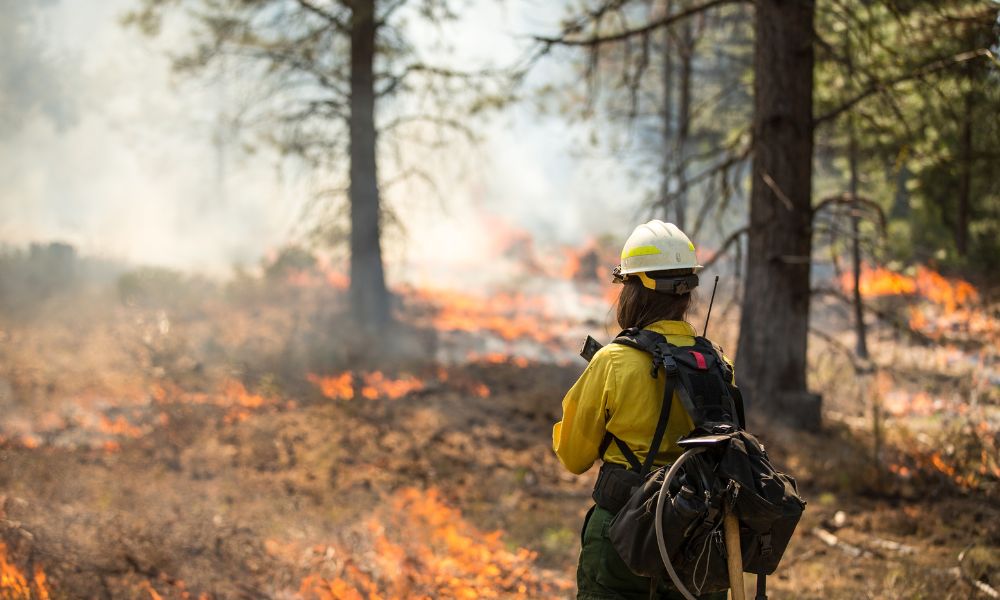
As the old joke goes, why do firefighters wear red suspenders? The answer: to keep their pants up! But here’s a more serious question: why do firefighters wear such specific helmets? The answer is a bit more detailed than you may think! Firefighter helmets are the result of 200-plus years of design, innovation, and adjustment. We’re here to provide a quick breakdown of why these helmets look the way they look.
There’s probably no piece of equipment more recognizable than a traditional firefighting helmet. Most people probably imagine the standard design: a helmet with a high peak in front and a stiff brim that extends out several inches in the back. But not all firefighting helmets look like those you associate with urban structural firefighters. The design for firefighting helmets has slowly evolved over the decades to meet the job’s demands and offer extra protection to the wearer. So, why are firefighter helmets shaped that way?
Historical Firefighting
Firefighting has existed since Ancient Rome and may even be older than that. Volunteers formed some firefighting companies, and others emerged due to special decrees by the emperor, king, or other type of ruler. Some of the early colonies in the United States had specially appointed officials who would patrol cities such as Boston at night to watch for fires and alert citizens. It wasn’t until 1678, however, that Boston formed its first fire engine company. A few decades later, Benjamin Franklin formed the Union Fire Company, a group of volunteers that put out fires in Philadelphia. Some private companies even had their own firefighting units. Government-overseen fire departments didn’t emerge until sometime during the Civil War. Like the history of firefighting, firefighting equipment likewise went through a lengthy evolution.
Hazardous Hats
The first firefighting helmets came about in Philadelphia in the late 1700s. They were called stovepipes because of their similarity to gentlemen’s silk hats of the same name and style. They featured wide brims and tall, firm crowns and helped to identify the members of a firefighting company. Truthfully, the hats provided little protection since they were ordinary hats, often made of silk. Mostly ceremonial, they were usually worn only at parades and other public events and acquired the nickname of parade hats. These hats often featured festive decorations and images of American patriots.
Leather Protection
The first hats identifiable as modern firefighting helmets emerged in the 1830s. A luggage-maker named Henry Gratacap served as a volunteer firefighter. Presumably, Gratacap recognized the opportunity to provide more protection to himself and other firefighters and went on to develop a helmet made of tough leather that could resist flames. The design featured tightly sewn leather on an interior framework of combs that formed a dome. The dome, of course, helped deflect debris and embers away from the firefighter’s head.
As the number of combs increased, the helmet became stronger, and a reinforced helmet could be removed and used to break through glass and other materials during a rescue. The extended brim in the back diverted water, often superheated during a fire, away from the firefighter’s neck and kept them dry. It also helped the firefighters stay cooler. The large flat front of the helmet further permitted the addition of identification numbers as well as company and unit names. Helmet makers added reflective material to the helmets to make it easier to find firefighters in the darkness caused by smoke from a blaze.
Tradition Meets Innovation
The design of a structural firefighter’s helmet stayed fairly consistent for many years, but technology advanced and provided greater protection. While fire-resistant leather was good, other materials were better. Helmets around the world incorporated different materials. Metal, usually brass, aluminum, or steel, became a common option. However, metal helmets provided no protection when electricity and electrical fires became more common, so some countries developed cork and rubber helmets.
Not long after World War II, plastic and fiberglass came to the fore as materials that provided plenty of protection and resistance to shocks and severe blows while remaining lightweight. Less weight meant less strain and stress on the firefighters’ necks and ability to move swiftly.
Into the Wild
While the traditional structural firefighter helmet remains the image in most people’s minds, invention and innovation have created more efficient headgear that provides greater safety while accommodating today’s technology. Modern helmets have started to ditch the extended “duck bill” in the back for a slightly less long but still protective brim. Modern helmets also accommodate goggles, visors, communication equipment, and other devices that firefighters need to attach or position around the helmet.
As we head to the great outdoors, we can see that wildland fire helmets leave the city and traditional structural firefighting helmets behind. NFPA 1977 helmets must also meet performance standards and specifications set by the National Fire Protection Association (NFPA) 1977 Standard on Protective Clothing and Equipment for Wildland Fire Fighting. With a design that focuses more on standing amidst burning trees and brush, wildland firefighting helmets have a full, all-around brim that gives protection without excess weight. Such helmets feature high-heat thermoplastic that protects the fighter from damage from heavy weights and embers. They also use reflective materials for identification in dim conditions, and the various straps and support inside provide shielding while allowing breathability, helping the firefighter stay cool.
How’s Your Helmet?
As we’ve explored why firefighter helmets are shaped that way, you might have noticed that there is more to this iconic headwear than you may have previously thought! If you have further questions about the best designs for wildland firefighting helmets for your unit, contact us today for a consultation. We offer a huge selection of helmets, personal protective equipment (PPE), tools and equipment, and more.
We’ve been operating for over 30 years and are staffed by personnel with experience and knowledge about wildland firefighting and the regulations covering protective equipment. Located in Colorado, we service the entire continent of North America, but we are ready to help wildland firefighters worldwide. Contact us for further information or to see how we can meet your needs and expectations!

